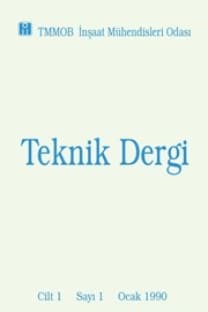BA yapılarda konsol kirişlere aktarılan ilave yükler
Additional loads transferred to cantilever beams of RC-buildings
___
- [1] Yang, D., Park S., Neale, W.K., “Flexural Behaviour of Reinforced Concrete Beams Strengthened with Prestressed Carbon Composites,” Composite Structures, 88, 2009, pp. 497–508.
- [2] Mukherjee, A., Rai, L.G., “Performance of Reinforced Concrete Beams Externally Prestressed with Fiber Composites,” Construction and Building Materials, 23, 2009, pp. 822–828.
- [3] Li, L. J., Guo, Y. C., Liu, F., Bungey, J.H., “Test Analysis for FRC Beams Strengthened with Externally Bonded FRP Sheets,” Construction and Building Materials, 23, 2008, pp. 315–323.
- [4] Bank, L. C., Arora, D., “Analysis of RC Beams Strengthened with Mechanically Fastened FRP (MF-FRP) Strips,” Composite Structures, 79, 2007, pp. 180–191.
- [5] Toutanji, H., Zhao, L., Zhang, Y., “Flexural Behavior of Reinforced Concrete Beams Externally Strengthened with CFRP Sheets Bonded with an Inorganic Matrix,” Engineering Structures, 28, 2006, pp. 557–566.
- [6] Anania, L., Badala, A., Failla, G., “Increasing The Flexural Performance of RC Beams Strengthened with CFRP Materials,” Construction and Building Materials, 19, 2005, pp. 55–61
- [7] Turkish Institute of Standards, “Requirements for Design and Construction of Reinforced Concrete Structures (TS500-02),” Turkish Standards, 2002, pp. 12, 24, 25, 63–64.
- [8] ACI Committee 318, “Building Code Requirements for Structural Concrete (ACI 318- 05) and Commentary (ACI 318R-05),” American Concrete Institute, 20, 2005, pp. 111–112.
- ISSN: 1300-3453
- Yayın Aralığı: 6
- Yayıncı: TMMOB İnşaat Mühendisleri Odası
Elastik zemine oturan kalın plaklar için kayma kilitlenmesiz bir sonlu eleman modeli
BA yapılarda konsol kirişlere aktarılan ilave yükler
Yunus EKİNCİ, Bengi AYKAÇ, Sabahattin AYKAÇ
Klor iyonu etkisindeki betonarme yapı elemanlarının dayanıklılığı için olasılığa dayalı tasarım
